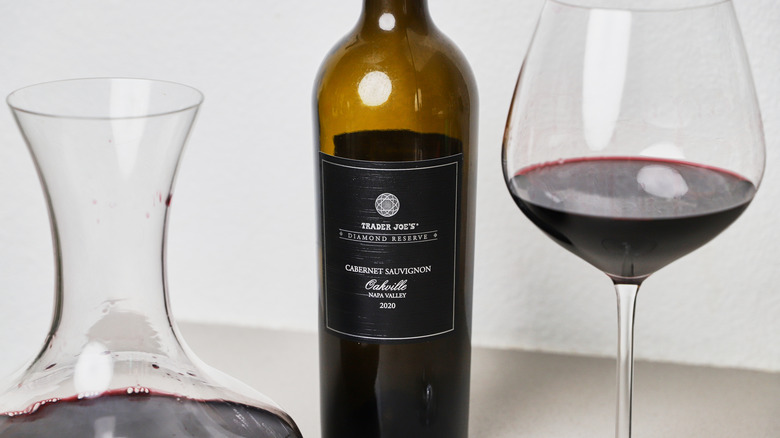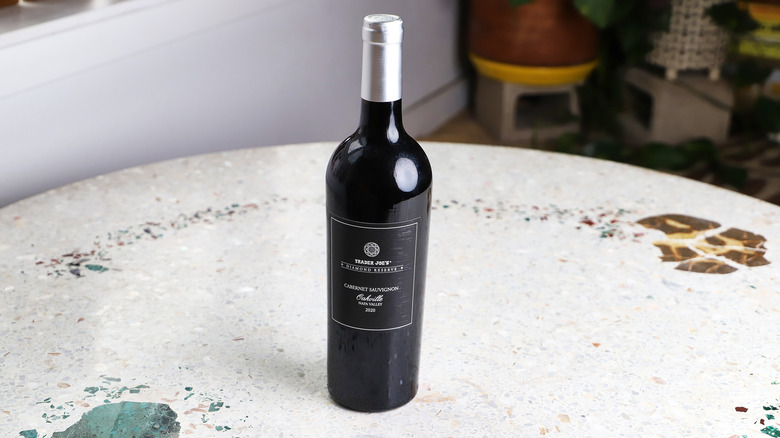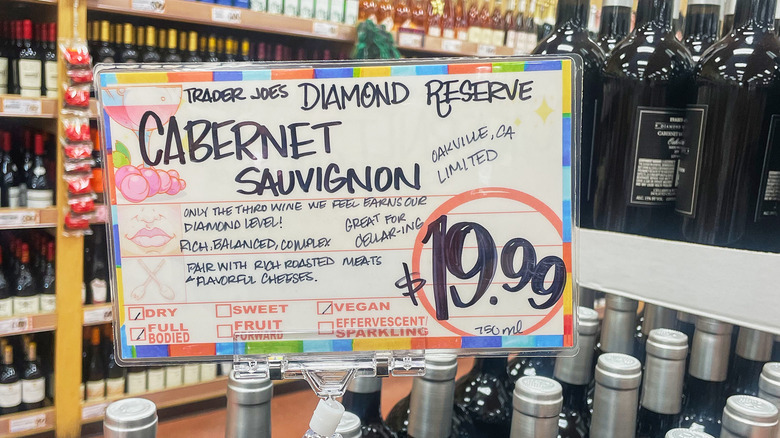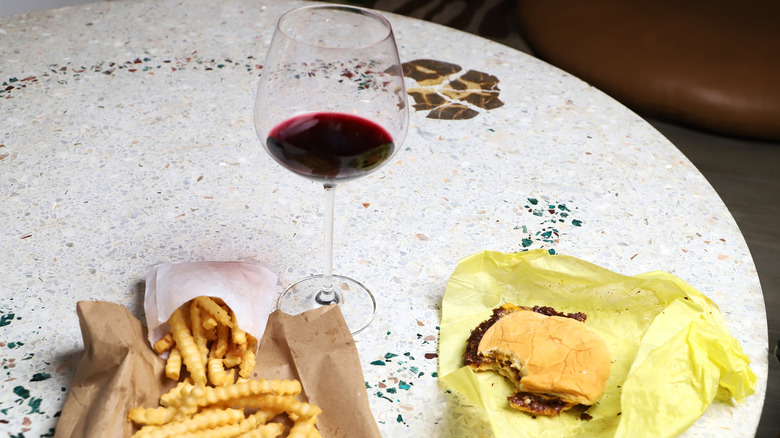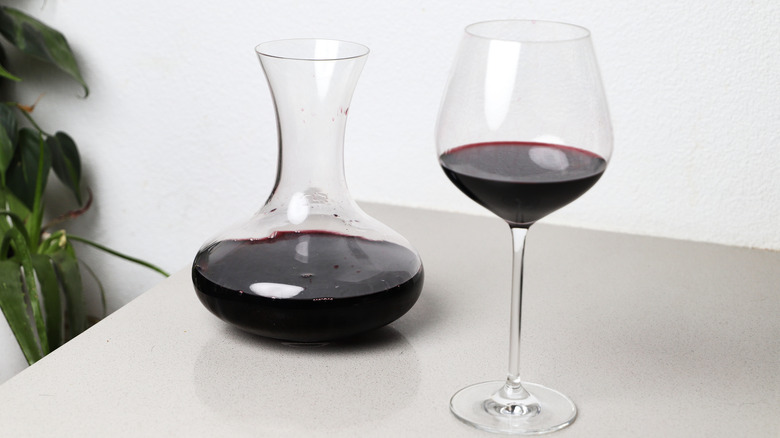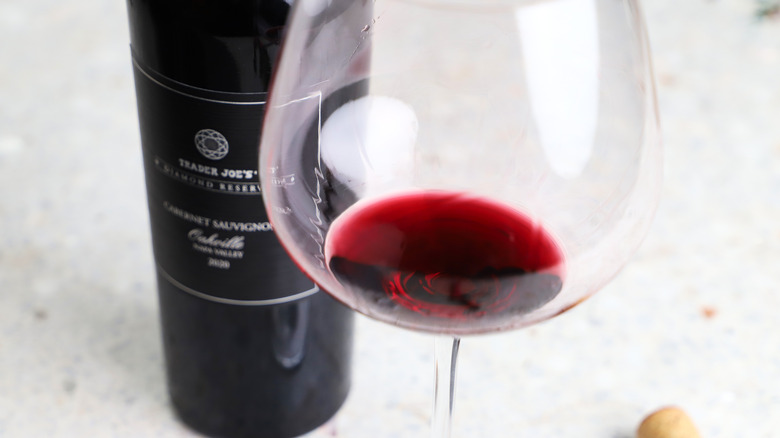Review: Trader Joe's Diamond Reserve Cabernet Sauvignon Shines
Trader Joe's is famed for its extensive wine selection, most notably it's budget-friendly Charles Shaw line, also known as Two Buck Chuck. But beyond these ever-popular entry-level bottles, you'll also find a class of higher-end cuvees that carry the TJ's label. The Trader Joe's "Reserve" label offers limited quantities of sparkling North Coast Brut, a Platinum Brut Sparking from Sonoma County, a sparkling rose, a Grand Reserve Pinot noir, a Petit Reserve Pinot, and (for a limited time) a Diamond Reserve Cabernet Sauvignon, notoriously released every year around the holidays.
A natural pairing for the traditional roast beef, and hearty stews many of us enjoy when the weather cools, cabernet sauvignon matches the holiday spirit with considerable heft, tannins, and oftentimes even notes of baking spice. To test how the latest vintage of Trader Joe's prized Diamond Reserve Cab measures up, we uncorked (and decanted) a bottle of the grocery store's 2020 pressing and put it to the test.
The wine's origin is unclear
Because of the mysterious sourcing of its namesake labels, we'll never know for certain where Trader Joe's food or wine comes from but the brand does let its consumers know that the 2020 Diamond Reserve Cabernet Sauvignon derives from a sub-region of Napa Valley known as Oakville. Nestled between Yountville and Rutherford, Oakville's wine output relies on 70% cabernet sauvignon (via wine-searcher) and is home to some of the region's most well-known growers of the grape, including Turnbull Wine Cellars, Ghost Block Estate Wine, Cardinal Estate, and several other highly regarded wineries.
The store's website description of the 2020 Diamond Reserve Cabernet Sauvignon even teases the wine's high-class but undisclosed origins, insisting its' provenance remains under wraps in order to keep the price of the bottle low. The mystery, of course, leaves our curiosities piqued as to which of the Oakville winemakers are responsible for this year's vintage, and exactly how much we're saving when we grab a bottle donning the Trader Joe's label.
Further obscuring the wine's source is the youngness of the grapes — while lighter-bodied varietals such as pinot noir and zinfandel are oftentimes aged and released the year following its picking, most Californian Sauvignons are aged in its vessel (often oak) for over a year, making 2020 a fairly quick release for the specific grape (most of the Oakville winemakers offer only 2019 or older vintages).
It won't be available for long
Unlike most of the other wines it offers, Trader Joe's official website prohibits its guests from adding Diamond Reserve bottles to their virtual shopping list, most likely due to the fluctuation of the cabernet sauvignon availability. We reached out to our favorite chain store regarding the Diamond Reserve's stock list but didn't hear back from them before publication.
However a kind, Hawaiian-shirt-wearing Trader Joe's employee at our local store let us know that Diamond Reserve has its share of devotees and while the cab's display was flush when we grabbed our bottle, the same might not stay true past the holidays.
We do suspect that the bottle's hype might be slightly overblown and if you're lucky enough to live in an area blessed with several Trader Joe's locations, for the time being at least, we're nearly sure you can track down a bottle — we suggest opting for the largest Trader Joe's location in your area since they also usually possess the most built-out wine and beer sections. If you strike out, a Trader Joe's employee might be willing to locate a bottle for you through the chain's internal inventory system and even go the extra mile and call the branch with your wine and hold it for you there.
But, if we were to do it all over again next year, we'd set a handy Google reminder in our phone to ping us a week after Thanksgiving and start popping into the grocery store with our eyes pealed for its tower of Diamond Reserve.
How much is it?
The $19.99 (plus tax in most states) price tag for the Diamond Reserve Cabernet Sauvignon sits roughly $5 above most other wines stocked on the shelves of Trader Joe's. Two Buck Chuck this is not, and even compared to Trader Joe's "Reserve" wines, which are between $12.99 and $19.99, Diamond Reserve is the pinnacle of that price range.
When compared to the store's other cabernet sauvignons, the cost of Diamond Reserve is more than double that of most of Trader Joe's offerings. However, if you're to venture outside the automatic doors of Trader Joe's, the cost of cabernet sauvignons range wildly. Bottles of the same grape variety, terroir, and vintage vary in price from $21.99-179.99 (via Wine.com), making Trader Joe's Diamond Reserve a relative bargain overall. In any case, nabbing an above-average bottle of (especially red) wine for under $25, from anywhere ranks as a win overall.
How does it taste?
As we sliced through the bottle's foil and pulled out its nondescript, unmarked cork we were met with exactly what we expected — notes of sharp, spiced tobacco, with a musky, hot edge of alcohol that quickly settled down after breathing in our glass for 10 minutes. After another 30 in a decanter, the wine continued to soften and the nose, once stacked with punchy clove notes, relaxed into a more subtle vanilla, and its tannins also became silky after being left in a wide-mouthed vessel for a half hour.
Considerably less oaky than cabernet sauvignons that we regard as synonymous with the Napa region, Diamond Reserve Cabernet Sauvignon pours dark, almost the purple hue of Welch's grape juice, and boasts a medium body with a balanced structure and so much tannin that, on its own, the wine has a nearly astringent quality. With food, however (we opted for a smashburger and fries), the drying effect of the tannins prepares the palate for another bite of meaty, greasy goodness and we were able to detect the wine's more delicate notes of boysenberry and sour plum. A day later, the cabernet sauvignon and its tannins mellowed even further to a pleasant, sippable glass pour, and those fruity notes revealed themselves more with a flicker of the wine's acidic promise.
Much more refined and balanced than we anticipated, the 2020 Diamond Reserve Cabernet Sauvignon knocked over our preconceived notions of the quality of wine wearing a Trader Joe's label.
How does it compare to other cabernet sauvignons?
Honestly, we enjoyed this one about 50% more than most cabernet sauvignons we find on glass pour lists. Though it might not exactly reflect our style of wine drinking, we found it to be less intrusive, happily subdued, and a great match for red meat. So many Napa Valley wines taste overwhelmingly of the new oak they're aged in, wiping out the grape's buoyant flavor, but the 2020 vintage of Trader Joe's Diamond Reserve Cabernet Sauvignon preserves the lively notes of the grape and stands tall against wines of its ilk.
While uncorking the bottle, we braced ourselves for a nose full of oak and little fruit. Instead, we were met with a balanced, silky interpretation of a Napa cabernet sauvignon with a gentle acidity that hints the wine is suitable for aging. So, though we enjoyed our glass of Diamond Reserve just two years after the grape's harvest, our curiosity remains piqued by how well the bottle might benefit from a few years in the cellar (or a cool, dry closet).
Praise aside, we highly suspect the presence of higher-than-desirable levels of sulfites and other additives in the wine, which negotiated how it sat with us over the course of the evening. After enjoying just a glass and a half, we felt the slight lethargic plucking of a very low-grade headache the following morning, reminding us why (most days) we stick to the world of natural wine.
Grab a few bottles of Diamond Reserve while you can
Like other Trader Joe's greatest wine hits, we presume the bottle's origins derive from a highly regarded maker and the contents of the bottle would warrant a price tag higher than $20 if the label was different. Though we wouldn't bring a bottle of Diamond Reserve Cabernet Sauvignon home regularly, it'd be a welcome addition to a potluck or dinner party where several bottles of wine float about the table.
As we began the assignment of assessing this Trader Joe's bottle, we anticipated tossing the remaining three glasses into a stew or boeuf bourguignon, but instead, we happily sipped them over the course of a couple of days. The wine's stability after uncorking comes at the cost of negotiating the cleanliness and credibility of Diamond Reserve in the natural wine community, but nevertheless, we hand it to Trader Joe's for managing to wrangle a deal with a legitimate winemaker that turned in a satisfying, drinkable explanation of Californian Cabernet.
While Diamond Reserve lacks a distinct personality of its own and tastes a little generic, the wine (especially for the price) surpasses most other Napa cabernet's in its price range and will no doubt be a crowd-pleasing, conversation starter for holiday meals centered around a piece of red meat. We'd guess the bottle would sell in the $50-65 range when sporting its own winemaker's label, and we're invested to learn where the wine called home before being adopted by the grocery giant.
